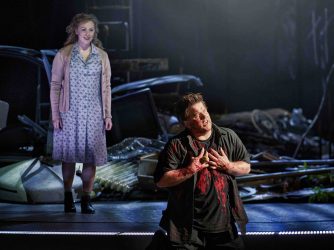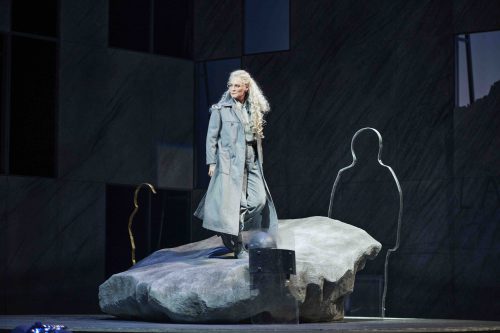 Sweden Wagner, Siegfried: Soloists, Dancers, Gothenburg Opera Orchestra / Evan Rogister (conductor). Pre-recorded on Gothenburg Opera main stage for digital streaming only and premiered 26-28.3.2021. (NS)
Sweden Wagner, Siegfried: Soloists, Dancers, Gothenburg Opera Orchestra / Evan Rogister (conductor). Pre-recorded on Gothenburg Opera main stage for digital streaming only and premiered 26-28.3.2021. (NS)

Production:
Director – Stephen Langridge
Set and Costume design – Alison Chitty
Set and Costume design assistants – Fabrice Serafino, Louie Whitemore
Lighting design – Paul Pyant
Movement instructor – Annika Lindqvist
Cast:
Siegfried – Daniel Brenna
Mime – Dan Karlström
Wanderer – Fredrik Zetterström (Acts I and II) / Anders Lorentzson (Act III)
Alberich – Ólafur Sigurdarson
Fafner – Mats Almgren
Erda – Hege Høisæter
Woodbird – Sofie Asplund
Brünnhilde – Ingela Brimberg
The Seven Narrators (silent roles): Sara Suneson (The Golden Child), Julie Dariosecq, Sara Wikström, Jérôme Delbey, Jonathan Böiers, Felix Skalberg, Ida On
Stephen Langridge’s Gothenburg Ring cycle has as a key theme the destruction of nature, but no one in their worst nightmares could have imagined that the four-year project would come close to being derailed by a pandemic that many argue is the result of mankind’s exploitation of nature and the shrinking habitats of wild animals. The doors of all large theatrical institutions in Sweden have been firmly closed to live audiences for nearly twelve months as I write this.
But necessity is the mother of invention, which in the case of the Gothenburg Opera has introduced the house to streaming performances online (click here), at first chamber works and small concerts with singers and now recently ‘one-on-one’ dance with one dancer performing for one live audience member. While all other opera and musical productions have been postponed or cancelled, the house was determined to stage Siegfried.
The result is impressive in its continuity with the two previous parts Das Rheingold and Die Walküre. The basic set design with moveable walls of recycled wood is cleverly used and lit atmospherically by Paul Pyant, in particular in the dark and foreboding opening of Act II where the gloom is pierced by electric torches, picking out items of the junkyard surrounding Fafner’s Neidhöle (literally a hole in the stage). Projections of still pictures or short scenes from the earlier parts of the Ring complement the narration and memories of the characters.
The high rates of Covid-19 in Sweden during the periods the performance was recorded caused a number of practical challenges; the ones that are most noticeable in the final film are the two Wanderers and the distance enforced between all singing characters on stage. At first the distance between Siegfried and Brünnhilde in the final scene of Act III felt rather strange, but Langridge achieved elegant solutions for Siegfried’s kiss and the increasing rapture of the couple so that by the end the choreography felt natural.
Of the two Wanderers, Anders Lorentzson was familiar from the first two parts of the Gothenburg Ring and kept to the same high standard in Act III, with a particularly sumptuous lower register. He was a commanding presence, gripping in his confrontations with Erda and Siegfried. Fredrik Zetterström (previously reviewed as Wotan in 2011) had a gorgeous warm baritone and acted perceptively in his meetings with Mime and Alberich, but sometimes sounded slightly ragged when unleashing his fortissimo.
Ólafur Sigurdarson made a gripping return as Alberich, visibly consumed by his obsession with the ring and demonstrating the great range of expression in his baritone. Particularly impressive was his nimbleness in changing vocal colour from one word to the next, particularly as he alternately taunted and cursed the Wanderer. Dan Karlström, new as Mime, was a revelation: a vocal timbre which captured the dwarf’s whining without being ugly and consummate acting. He was compelling every minute that he was onstage.
Fafner (Mats Almgren) and Erda (Hege Høisæter) were both moving in their brief roles, with Fafner in particular showing a sorrow that is absent in his character in Das Rheingold. Sofie Asplund’s luminous voice was a wonderful choice for the Woodbird, and she acted sensitively as Siegfried sees something of his mother in this kind bird. The Seven Narrators are again used thoughtfully and are onstage for much of the action.

Ingela Brimberg made a promising start as Brünnhilde. She was gripping in telling her story to Siegfried and displayed a warm vocal tone, in particular in ‘Ewig war ich’. At the same time her voice had a shining top and was thrilling in the rapturous finale. Daniel Brenna was a fantastic choice for Siegfried: his Heldentenor has plenty of room for warmth and subtle expression, but at the same time Mr Brenna could convincingly act as the brat that Siegfried is in the early parts of the opera. Subtleties in Langridge’s direction and Evan Rogister’s conducting were fully reflected in Siegfried’s character and singing, for example in his musicality and dynamic range in the final scene of Act I, which can in other hands degenerate into tedious fortissimo bombast. His chemistry with Brimberg’s Brünnhilde was convincing and their impassioned duet glorious.
As in Die Walküre, Rogister’s conducting of the orchestra was in balance with the singers and brought out some lovely colours, in particular in the beginnings of Acts I and II where the orchestra encapsulated the atmosphere of darkness and evil. (The orchestra is of full Wagner size but spread out of the pit and into the stalls for this production.) If the Prelude to Act III lacked thrills this was amply made up for with a beautiful transition to the final scene and a building rapture leading to a glorious end in ‘Leuchtende Liebe, lachender Tod’.
Niklas Smith
Streaming until the end of 31 March (Swedish time). No payment or registration required. Links to each act (with English subtitles) and pre-premiere interviews available on the Gothenburg Opera website. Programme booklet (with English-language article by Stephen Langridge on page 35) available here.
